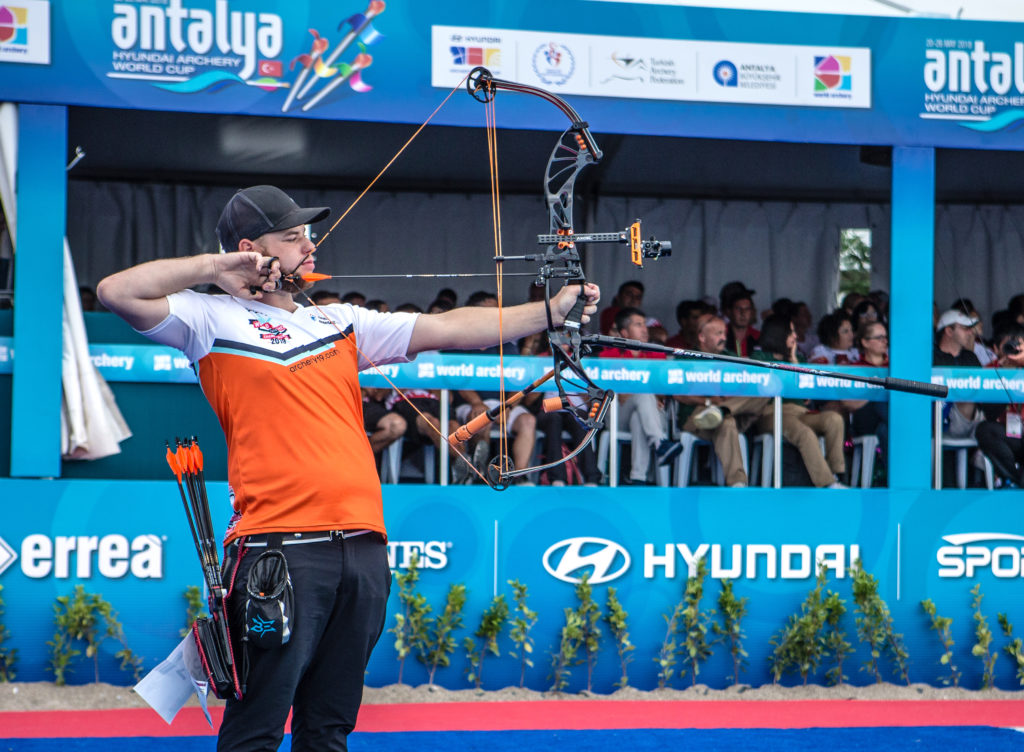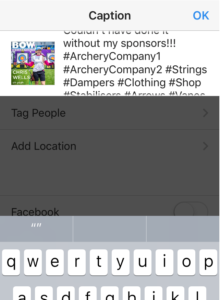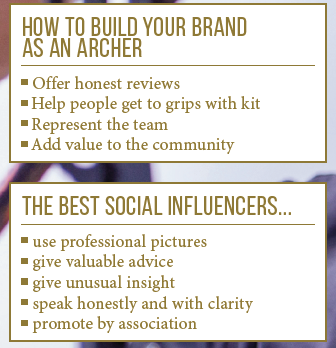Personal branding for archers requires some creativity. By Chris Wells.
There’s an epidemic of hashtags in the archery world. It seems to be the norm that whenever somebody completes a tournament, they’ll thank their sponsors on social media – and usually with a long list of @s and #s to finish off the post, up to 20, in some cases.
I know some guides to ‘how to be a success on Instagram’ tell you do do things like this, but I don’t like it. It reminds me of someone selling make-up to friends through a Ponzi-style pyramid scheme – lots of noise, but little substantial content. More to the point, I wonder if any of these posts actually convert into sales for the sponsoring company?
That is, after all, what sponsorship is designed to achieve: sell more product. It’s a cost-income operation, with sponsorship budgets proportional to the value the sponsored activity brings to the company. Top archers get more in sponsorship, and some even might manage to draw a salary. More commonly in the archery world, people receive free equipment.
It’s worth noting that some of the world’s best archers rarely speak or communicate on their equipment. You won’t see Mike Schloesser, for example, posting after each event with a long list of thanks – but, then, he’s just walked away with gold at the second stage of the 2018 Hyundai Archery World Cup and had his performance filmed, broadcasted and photographed, recorded in history. You could say that the performance speaks for itself.
He’s probably advertising the equipment well enough for the sales performance of that gear to speak for itself, too – although getting sales statistics out of a manufacturer isn’t going to be easy.
However, enough of the manufacturers that do sponsor Mike use him and many of the other world-class athletes that find continued success at the international level in their own social posting and marketing materials to support those sales. Whether these archers are aware of the value of their own brand or not, they’re doing well enough on the tournament field to warrant investment.
In a widely diverse industry on location with limited – but improving – high-level video production, and only a few athletes able to compete at such a level, there’s not much opportunity to provide this kind of value for a sponsor.
So are hashtags the only way to broadcast a sponsors message for people who don’t make the finals at major events? Definitely not.
Archers who want to make a living out of (or at least supplement the expenses) of the sport need to be much more creative in creating value for potential supporters.
Performing in competition is, of course, important at every level, as is acting as an ambassador for the equipment in person. That doesn’t mean recommending blindly or giving general and unspecific support to equipment that an athlete is sponsored to shoot, but being honest and helpful. Offering to assist with tuning and advice is far more valuable than well-he-would-say-that comments about how good a bow is.
Giving honest and realistic reviews about getting the most out of a piece of equipment will help someone get to grips with it, lending any endorsement more weight.
For example, Brady Ellison, in a recent interview about customising gear, was very honest about the models of Hoyt riser he simply couldn’t get on with. So when he says his current piece of gear works for him, you believe it. Brady, of course, is high-profile enough to have started his own line of archery accessories, but not everyone is so lucky.
It’s actually a difficulty for magazines, too. With advertising required to finance printing, walking the fine line between honest reviews about equipment and not upsetting the income stream that pays the bills – and in an industry that’s largely funded from within, it’s tough.
This aimed-for honesty and accessibility isn’t just about being open, is actually basic principles of good customer service – and creating a brand as an athlete. And that’s what should replace the hashtags.
Unfortunately, in the modern world, individuals can make an entire career out of being a ‘social influencer’ – or having so many followers on an internet platform that the value of communicating to that audience is equivalent or outweighs a company buying advertising on television or otherwise. You may have read about major celebrities earning hundreds of thousands of dollars for a single Instagram post; although legislation in various countries is now forcing individuals to admit when they are paid to advertise in this way. Communities grow around these influencers because they are popular and famous – or, in rarer cases, interesting.
In the archery community, it’s interesting that should be the aim. Positive, clear pieces of content that add value to the community – things like advice, tips, interesting insights, even celebrating a good result or just entertaining activities – will promote an archer and, subsequently, any sponsors.
Young USA archer Chris Bee has done it right, with his #Beecast (we’ll excuse him this particular hashtag) and YouTube content. Some of the jokes are perhaps difficult to understand outside of his circle, but the content and intent is interesting.
Multiple world champion Jesse Broadwater’s Facebook page shows snippets from his career as a professional. It’s honest, it rarely directly mentions any particular sponsor – but his activity and personality is a great advert. The way he carries himself as a professional archer carries forward naturally to what he produces for social media.The immense stocks of knowledge and sporting and technical experience built up by many archers is enormously valuable both to people starting out and further on their archery journey. People always want to know how to grow and improve. If you can communicate it (in any language), you could be on to a winner.
And this mentality isn’t just reserved for athletes. Lancaster Archery in the US and, to a lesser extent, Merlin Archery in the UK – have driven brand growth through valuable content creation. Merlin took the time to grow a YouTube channel over a number of years and Lancaster has a large editorial staff creating written and video content that both promotes stock and gives real-world advice to make the brand a destination. The audience can visit the brand to learn – rather than just buy, but it’s helped grow sales exponentially over the years. Obviously not everyone has the resources to do something like that, but remember that social media is a skillset that can be always improved and is worth investing time in, if not money.
There is also value in taking time and care over what you post, and making sure it has an impact. London 2012 Olympic winner Ki Bo Bae, went quiet on social media after she missed making the Korean team this year and barely posted on her social network – but when she did, the interaction was massive and promotion within the archery community huge.
So how does this all practically apply to archers on the line? Previously, we established how team identity was important and in Bow 124, we talked about how easy it was to create valuable video content, expand the audience and promote the sport. It’s down to archers to make it happen.
Unless you’re shooting world-record scores right now, it’ll take some hard work until companies are queuing up to sign you to a lucrative sponsorship deal. Until then, build up a brand as an ambassador and leader within the community. Hopefully, you’ll find the value that you can offer might be higher than your scores – and you won’t need to list a load of hashtags.





